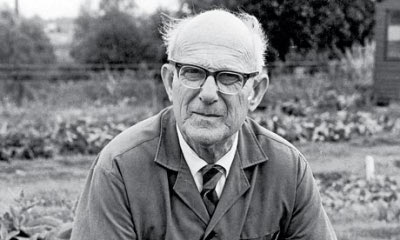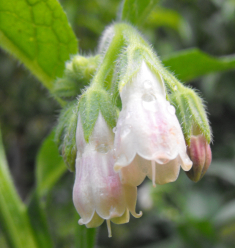
Lawrence Hills on comfrey
 Books
in the popular press about permaculture are quick to sing comfrey's
praises, but they are much slower to give any practical advice about
how to use the wonder plant. When I discovered that an entire
book was written about comfrey in 1953, and that it can be downloaded
for free from the Soil and Health library, I had to check it out.
Books
in the popular press about permaculture are quick to sing comfrey's
praises, but they are much slower to give any practical advice about
how to use the wonder plant. When I discovered that an entire
book was written about comfrey in 1953, and that it can be downloaded
for free from the Soil and Health library, I had to check it out.
Lawrence D. Hills' Russian
Comfrey: A Hundred Tons an Acre of Stock Feed or Compost for Farm,
Garden or Smallholding
details the history and uses of comfrey from a British
perspective. I was surprised to read that comfrey has been used
for over two hundred years in the United Kingdom, where the plant is
praised for the high protein content of the leaves and for its prolific
growth. One farmer planted a quarter of an acre of comfrey, which
provided feed for three cows and two horses, while others
feed comfrey to poultry and pigs. The same qualities make comfrey
a great crop to create copious compost or compost tea.
On the other hand, Hills
is quick to point out that not all farmers love
the wonder crop. Comfrey was immensely popular in the mid 1800s,
but soon letters started appearing in agricultural publications and
newspapers. Hills wrote:
So, what's the deal? Is comfrey worth its salt? How should it be grown and used? Stay tuned to hear the answers in this week's lunchtime series.
(By the way, all of the black and white pictures in this lunchtime series, with the exception of the one above of Lawrence Hills, are taken directly from his book.)
Escape the cubicle with Microbusiness Independence.
| This post is part of our Comfrey lunchtime series.
Read all of the entries: |
Want more in-depth information? Browse through our books.
Or explore more posts by date or by subject.
About us: Anna Hess and Mark Hamilton spent over a decade living self-sufficiently in the mountains of Virginia before moving north to start over from scratch in the foothills of Ohio. They've experimented with permaculture, no-till gardening, trailersteading, home-based microbusinesses and much more, writing about their adventures in both blogs and books.
Want to be notified when new comments are posted on this page? Click on the RSS button after you add a comment to subscribe to the comment feed, or simply check the box beside "email replies to me" while writing your comment.

The roots of the comfrey (Symphytum Officinale) are useful for helping wounds and even broken bones heal. They contain a compound that promotes cell division. But internal use is discouraged because of the alkaloid content.